Family law is an area of the legal field concerning matters relating to marriage and partnership, divorce, adoption, surrogacy, child protection from abuse and neglect, and other domestic issues. In the last century or so, the transformation of certain definitions (e.g. wife, marriage, gender) and the recognition of women’s rights have dramatically changed the practice. Over the past few decades, one group has made it their mission to reform family law and the family court system further—fathers. Join us as we use HeinOnline to investigate the history of family law and the relatively new fathers’ rights movement.
Before We Get Started
Don’t miss out! Make sure you have the databases we’ll be mentioning in this post. Follow the links below to start a trial today.
- Law Journal Library
- National Survey of State Laws
- Subject Compilations of State Laws
- Women and the Law
- World Treaty Library
A Brief History of Family Law
For centuries in Europe (and later, colonial America), family-related matters were deeply entangled with the law of property—marriage, child custody, and legitimacy were framed as matters of transferring or retaining one’s holdings. Upon marriage, the wife’s legal identity was absorbed by the husband (as was her personal property), and his role was to care financially for her and their children. William Blackstone, an 18th-century English jurist and politician, put it like this: “By marriage, the very being or legal existence of a woman is suspended, or at least incorporated or consolidated into that of the husband, under whose wing, protection, or cover she performs everything.” Husbands were considered the head of the household, and because they were the financial providers, fathers were granted complete custody rights to their children.
In the nineteenth century, the women’s rights movement gained traction, led by notables such as Elizabeth Cady Stanton and Susan B. Anthony. At around the same time, philosophers and budding psychologists began to study the nature of the child. Both women and children were soon discovered to have more agency and worth than previously thought. For women, the mid-1800s saw the passage of state laws granting them the right to own property. In 1848, New York’s Married Women’s Property Law became the basis for the legislation of other states. By 1900, nearly every state (with the exception of South Carolina) had also passed legislation providing for judicial divorce. To learn more about the rise of the women’s rights movement in the nineteenth century, visit HeinOnline’s Women and the Law database.
The newly available option of divorce now raised the question of child custody. Women were now allowed to own property, and increasingly joined the workforce—they were able to provide for their children. What’s more, children were now considered to have interests of their own, and the growing field of psychology pointed to the mother as crucial for their development. As a consequence, the “tender years” doctrine appeared, proposing that the mother should have rightful custody of younger, developing children. The doctrine would last through to the mid-20th century.
Beginning around the 1970s in the United States, the tender years doctrine was gradually replaced by that of the “best interests of the child.” This doctrine, perhaps derived from efforts toward the UN Convention on the Rights of the Child, became used by family courts to determine where children will live, the level of contact with each parent, and the amount of child support (if any) paid by either parent. The doctrine is still in use today.
The Fathers’ Rights Movement
According to their website, the fathers’ rights movement is “passionate about empowering fathers to stand up for their rights and to educate the public and family court system about the importance of fathers in society, as well as bring greater awareness to the imbalance and injustice that affects the rights of fathers.” Members of the movement argue that the current practice in family courts is discriminatory against fathers, and that it routinely violates the father’s fundamental right to parent his child (as well as the child’s fundamental right to have a relationship with both parents). They criticize the “best interests of the child” standard as being incredibly subjective, and claim that the “tender years” doctrine is still often used—if not actively, then subconsciously.
The movement’s primary goal is to establish formal legal rights for fathers, and to effect change in family law relating to issues such as child custody and child support. For example, many members campaign for a rebuttable presumption of 50/50 shared custody in the event of divorce or separation, allowing children to automatically spend equal time with each parent, unless contested. Others also call for a reformed child support model that bases payments on the estimated costs necessary for both parents, accounts for informal “payments” such as groceries and other necessities, and that can be terminated under extenuating conditions. Additional concerns of fathers’ rights groups include the amount of parenting time allowed for fathers, parental rights in the event that the mother becomes unfit, and the right to prevent women from having an abortion without the father’s consent.
To achieve their goals, some members believe public demonstrations are the only way to truly increase awareness of the issue. One member even self-immolated in front of a New Hampshire courthouse while advocating for the burning of courthouses and police stations. Other members of fathers’ rights groups remain committed to peaceful and non-violent action.
Researching Family Law Issues in HeinOnline
Researching Analyses of Family Law
When researching any topic in HeinOnline, we recommend starting in the Law Journal Library, our collection of more than 2,800 multidisciplinary journals. Try a simple search for “fathers’ rights” to get started, and then choose from a number of related topics to refine the results. We’ve chosen the topics of “Divorce,” “Child Custody,” and “Best Interests of the Child” below.
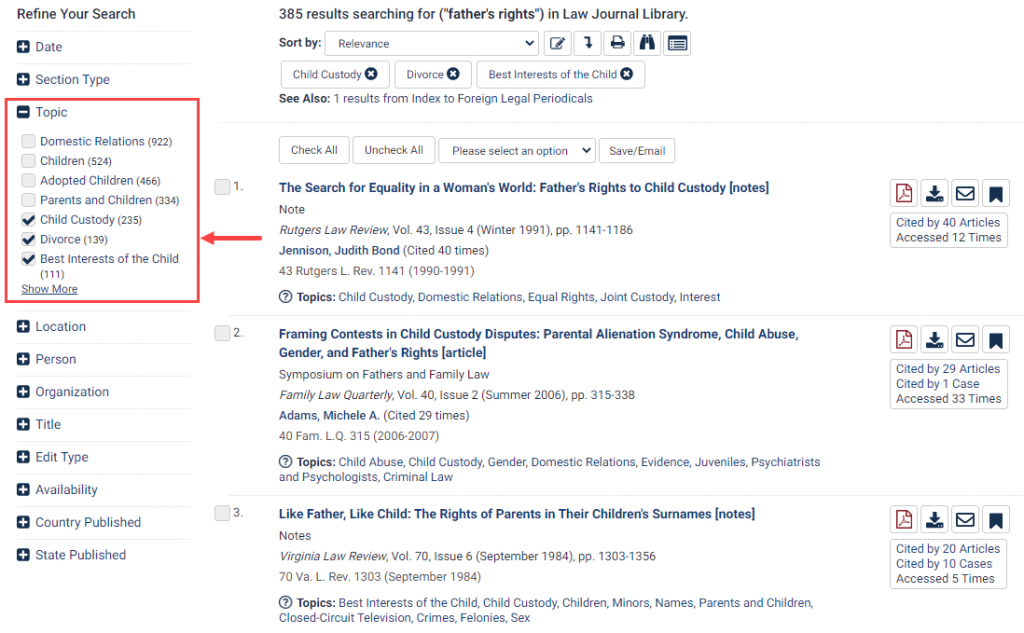
Upon filtering the results, these relevant titles appear:
- The Search for Equality in a Woman’s World: Father’s Rights to Child Custody
- Fathers, Gender Conflict, and Family Law: A Multidisciplinary Perspective
- She’s My Baby Too….A Father’s Road to Custody Resolution
At the same time, these thought-provoking titles provide differing perspectives on the fathers’ rights movement:
- The Parental Rights of Rapists
- The Natural Father, I Presume: The Natural Father’s Rights Versus the Best Interests of the Child
- A Fathers’ Rights Perspective on Custody Law in California: Would You Believe It If I Told You That the Law Is Fair to Fathers
- Distributing Children as Property: The Best Interest of the Children or the Best Interest of the Parents
Researching State Family Laws
Many laws relating to divorce, child custody, child support, and other family law issues vary by state. Use HeinOnline’s National Survey of State Laws and Subject Compilations of State Laws to easily investigate the differences.
To begin, navigate to HeinOnline’s National Survey of State Laws database. This database is updated regularly and provides an overall view of some of the most frequently sought-after and controversial legal topics in the United States. From the database home page, users will see a list of both categories and topics. To view all available related laws, select Family Laws from within the list of categories.
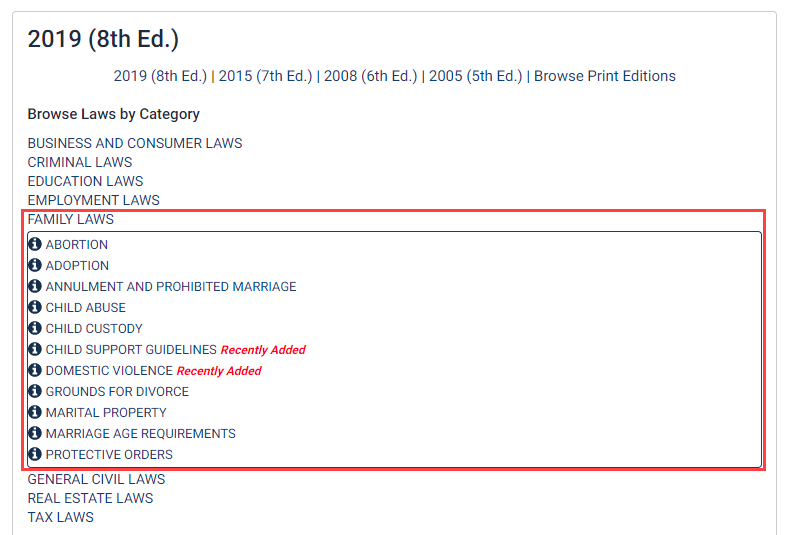
We decided to peruse family laws relating to child custody, and thus selected the relevant topic from the category listing. Selecting this link produces a user-friendly state-by-state comparison chart of child custody laws, complete with the year the act was adopted, whether joint custody and grandparent visitation are grantable, and whether the child’s wishes are considered.
Users will see, for example, that in all but five states, it is standard to award custody to both parents at the same time via “joint custody,” though the custody is not necessarily equal (the arrangements are later decided on by considering the best interests of the child).
Select a few states to compare them.
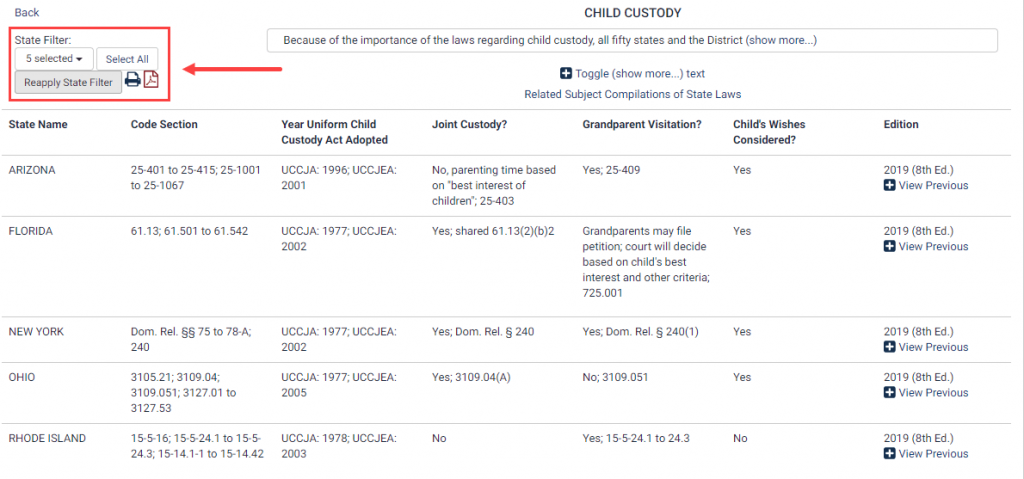
Finally, take advantage of this database’s built-in links to Cheryl Nyberg and Carol Boast Robertson’s Subject Compilations of State Laws. Long recognized as the most comprehensive source for identifying thousands of articles, books, government documents, and more, Subject Compilations of State Laws provides instantaneous access to more than 22,000 bibliographic records, many with extensive annotations.
Find related subjects from the resource listed at the top of the chart in National Survey of State Laws.
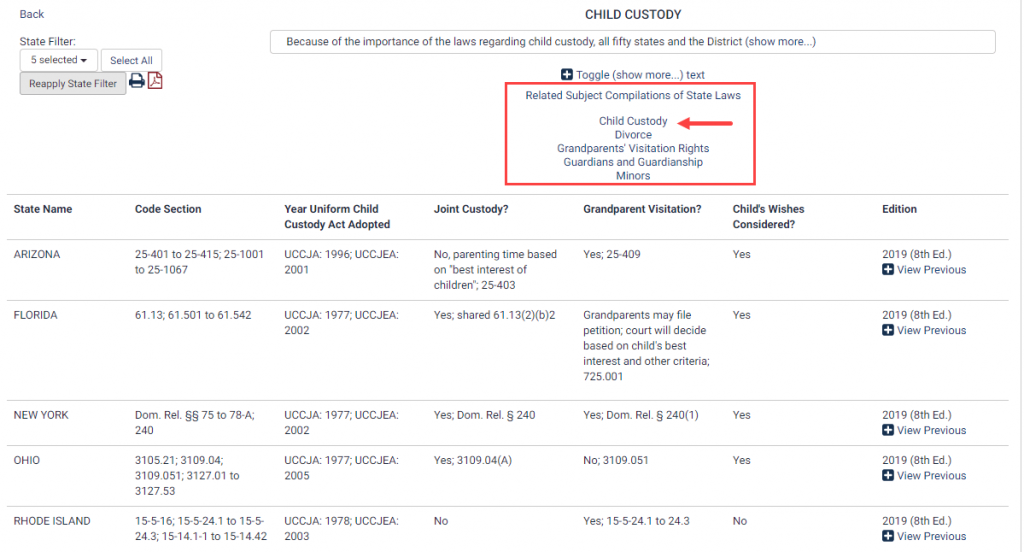
We selected “Child Custody” from the list of subjects in order to view hundreds of entries relating to the topic. Full-text links to the documents appear within the list of entries where available.
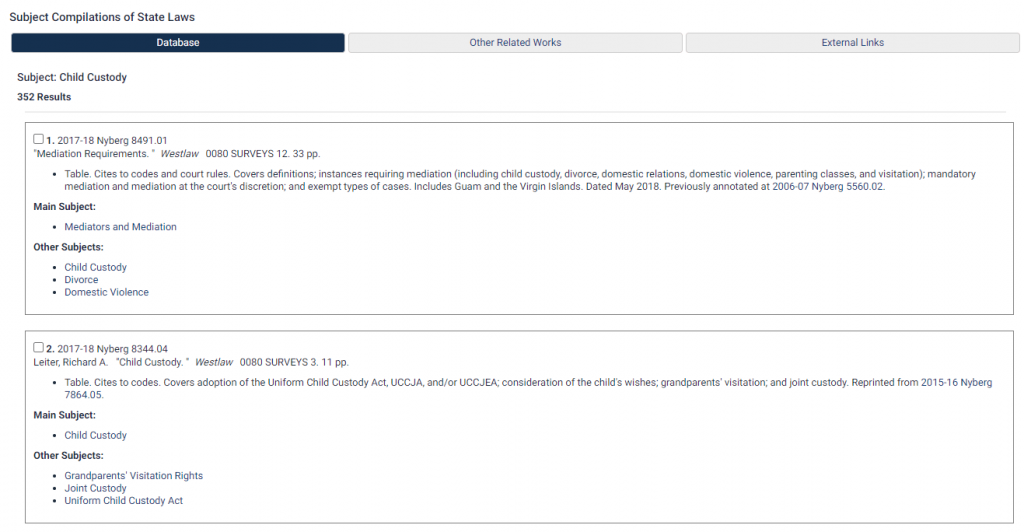
Interested in researching more hot topics with HeinOnline? Subscribe to the HeinOnline Blog to receive posts like these right to your inbox.



